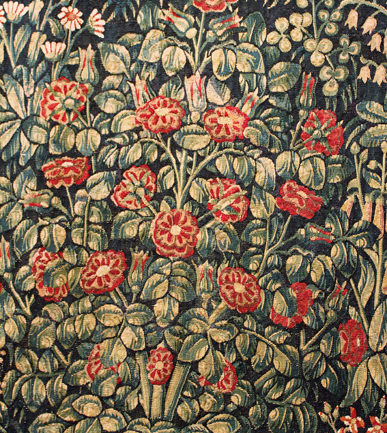This post is also available in: Italian
Flowers in the gardens, the nurseries, the woods and the meadows … but also painted, sculpted, and embroidered: we love the latter as well, don’t we? I found some of the best botanical-themed embroideries in Pistoia, which, as the very heart of the most important floricultural area in Italy, is also a magnificent ancient town. Halfway from Florence and Lucca, it is often ignored by the traditional tourist routes and that’s a real shame: Pistoia is a sheer delight to enjoy on a leisure stroll, admiring its Cathedral of Saint Zeno with the facade decorated by Andrea della Robbia (see full description below), the bell tower and the baptistery in Florentine Gothic style. Then, there’s the basement of Ceppo Hospital, included in the “Pistoia Sotteranea” guided tour (tel. 0573 368023), and Piazza della Scala, hosting the city market and several numerous historic establishments, wine bars, and restaurants. Not to mention Marino Marini Museum inside Palazzo del Tau, on Corso Fedi, which houses many works of contemporary art. Last but not least, visitors should see Museo del Palazzo dei Vescovi, which houses the spectacular “Millefiori” Tapestry, and Museo del Ricamo (Embroidery Museum) inside Palazzo Rospigliosi.
The “Millefiori Tapestry”, or of “Adoration Tapestry”, is a masterpiece of Flemish tapestry dating back to 1500 and was made in Flanders. It belongs to the Cathedral of Pistoia (it used to be exhibited inside the Duomo) since 2016 it has been a priceless treasure of the Museum of Palazzo dei Vescovi. When I visited it, I was truly amazed by its beauty. It’s huge and on its black background, there’s an opulent rendering of countless animals, plants, leaves, daffodils, fruits and flowers (hence the name “a thousand flowers”), all perfectly recognizable. There are hares, fallow deer, wolves, fawns, birds, and even a unicorn; among the flowers, there are dog roses, digitalis, daisies, irises, violets, primroses, carnations, bluebells, lilies, poppies, corydalis, lilies of the valley, snowdrops, clovers, tulips, etc. Let’s play a game: try to spot them in the pictures!
Museo del Ricamo (Embroidery Museum), on the ground floor of the wonderful Palazzo Rospigliosi, (in the historic centre of Pistoia), houses a collection of precious embroideries, made between 1600 and 1900, and the tools for that traditional craftmanship in Pistoia. Born in the 1600s and handed down over the centuries by the nuns of the cloistered monasteries, in the women’s schools and, later, by professional embroidery workshops, this kind of art has given life to wonderful embroidered fabric, mainly intended for the personal linen and residences of the richest families, ecclesiastical furnishings and highly expensive clothes. The floral themes always prevail, obtained with different techniques which have changed throughout the centuries. The superb museum exhibition includes a golden blanket, full of flowers, assorted fruits, and also insects and mice!
The facade of the Cathedral of Saint Zeno: it was originally built in the 10th century, although it has suffered various damages and further renovations; it can be seen in the beautiful Piazza del Duomo. The Romanesque style façade was remodelled between 1379 and 1449, with the addition of the portico and three orders of loggias. In 1505, Andrea della Robbia (a member of the famous family of local sculptors specialized in glazed terracotta), created the archivolt of the central portal, with its lunette dedicated to the Madonna with a Child and the Angels. The marvellous frieze of leaves, the flowers and fruits are part of a most unique and truly outstanding work of art: you can clearly see lemons, quince, pinecones of <em>Pinus maritima</em>, as well as white and blue beach moonflowers; not to mention the sweet rendering of the Holy Mary and baby Jesus.
On the upper part of the façade, there are two statues representing Saint Zeno, on the left, and Saint Jacob, on the right – the patron of the city. I’ve recently found out that each year, on July 21st, four days before the beginning of the patron saint festival, there’s a special ceremony: the statue of Saint Jacob is covered with a heavy red cloak, the symbol of the pilgrims (Saint James known by the locals as Saint Jacob, is actually their protector); such ceremony recalls the early life of the Saint, who used to be a drifter and a scoundrel himself before discovering the faith. As a livestock trader, the Saint used to cheat his customers, making false promises about the due payments: he would thus postpone the until warmer days in summer. When the farmers got back to him in the hottest months of the year though, Saint Jacob would put on his thick red clock and shamelessly pretend that cold days had not disappeared yet, hence further delayed payments…!
In July, also the Blues Festival takes place in Pistoia – it was held for the first time in 1980. Visitors should also go to some of the most important nurseries in the valley. The suggested itinerary it’s already on our blog (Going to nurseries: Pistoia, Tuscany / 3). Such a route will take you to:
<strong>Piante Mati</strong>, with its exhibition gardens (which also feature an excellent restaurant);
<strong>Vivai Breschi</strong>, featuring some incredible topiary works of art,
<strong>Donna di Piante</strong>, exhibiting collections of buddleias, hibiscus, crepe myrtles and many more;
<strong>Ladre di Piante</strong>, with spectacular hydrangeas and gardenias;
<strong>Oscar Tintori</strong> and his historic citrus fruits;
<strong>Rose Barni</strong> and his irresistible roses;
<strong>The Clematis nursery</strong>, specialized in those very beautiful plants.
The recommended itinerary also includes several suggestions about the must-see gardens in that area.
This post is also available in: Italian



Leave a Reply